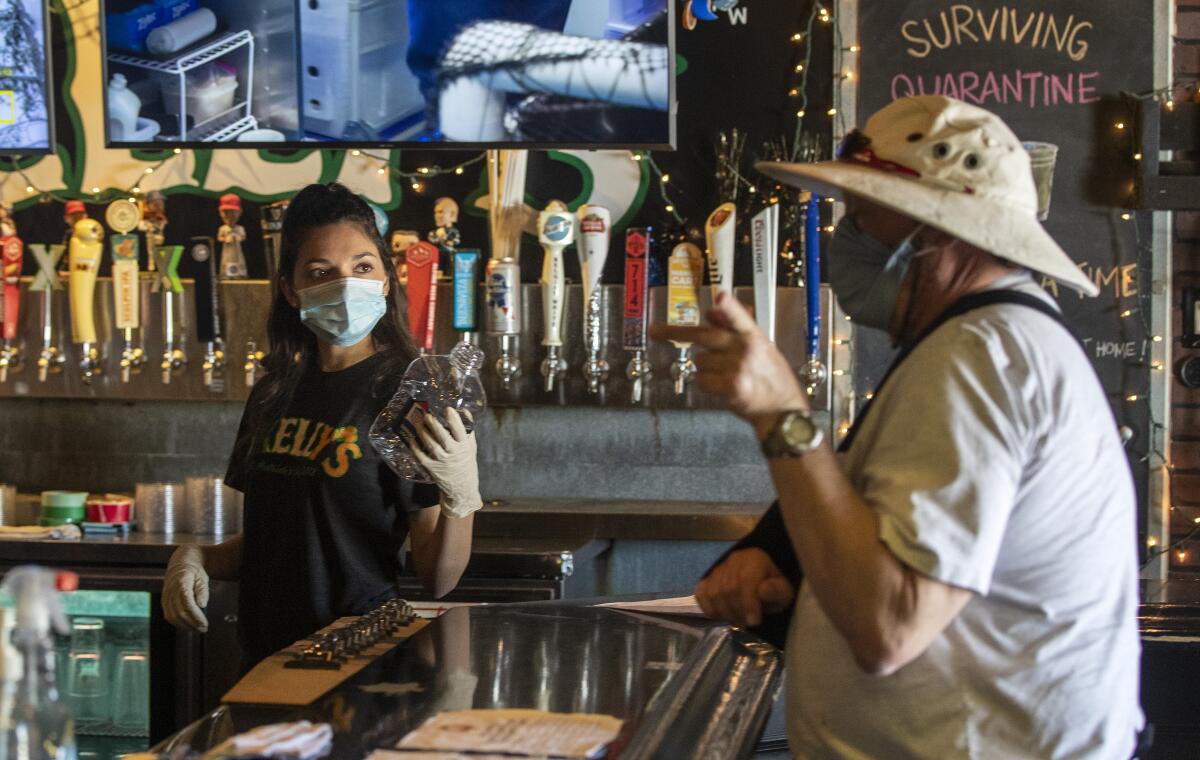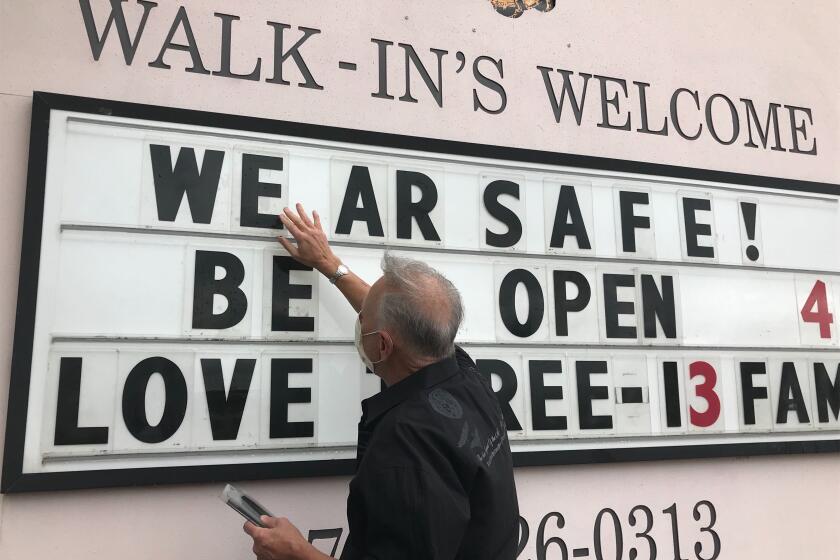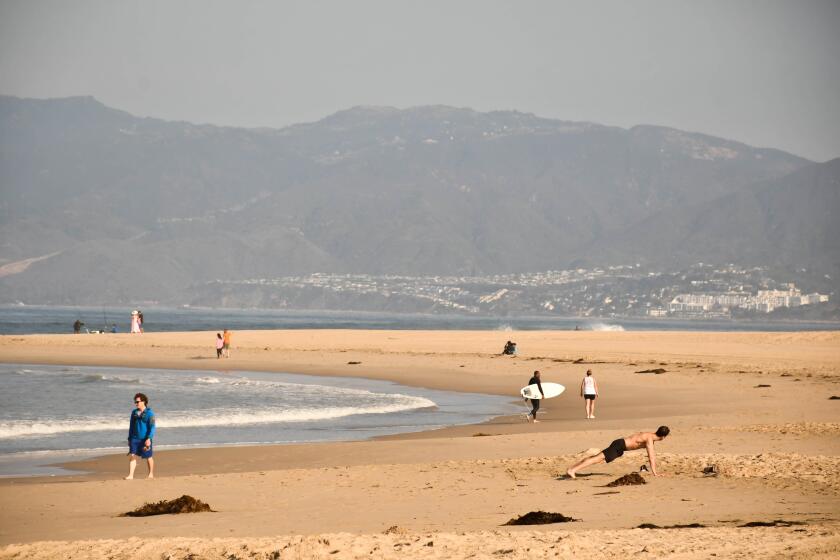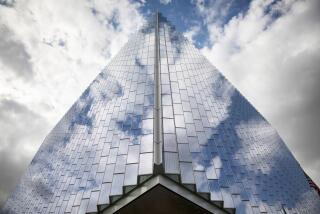Orange County must close bars, indoor restaurants amid coronavirus surge

- Share via
Bars across Orange County, many of which have only recently reopened, will be forced to shut down again beginning at midnight Thursday, authorities announced.
County officials on Wednesday announced the closure of bars, pubs, breweries and brewpubs that do not offer dine-in meals amid a troubling surge in coronavirus cases that has resulted in an increased hospitalization rate. The county’s order requires that establishments can serve alcohol only in the same transaction as a meal.
The county’s decision, under guidance from the California Department of Public Health, comes as coronavirus cases mount statewide, breaking records for new daily infections.
“While we would prefer not to close bars at this time, many of our neighboring counties have closed their bars, and it’s important to take precautions to ensure the safety of the general public,” Board of Supervisors Chairwoman Michelle Steel said.
A handful of Orange County restaurants have temporarily closed in the last week to deep clean and sanitize their spaces, some after discovering that employees had been infected with COVID-19, business owners said.
Less than two hours after the county issued its new order, Gov. Gavin Newsom announced that Orange County — along with 18 other counties — must immediately close bars and cease indoor operations at restaurants, wineries and tasting rooms, movie theaters, family entertainment centers, zoos, museums and card rooms. The new rules will remain in place for at least three weeks, Newsom said.
“This doesn’t mean restaurants are shut down,” Newsom said. “It means that we’re trying to take the activities, as many activities as we can — these mixed activities, these concentrated activities — and move them outdoors, which is a way of mitigating the spread of this virus.”
The change marks a major reversal in the state’s reopening process that began in early May and quickly progressed by June 12 to allow retail stores, dine-in restaurants, bars, religious services, card rooms, hair and nail salons, gyms and other businesses to open again with modifications in regions like Orange County that met state guidelines.
State officials and health experts have long anticipated that reopening would lead to an increase in cases and the risk of more deaths, a situation that has been playing out in Southern California for the past several weeks.
A new tracker from Johns Hopkins University lets you compare the trajectory of coronavirus cases in each state with the reopening policies there.
Orange County, which is home to more than 3 million people, has the fourth-highest number of coronavirus cases among the state’s 58 counties and the fourth most deaths.
Orange County confirmed five additional coronavirus-related deaths and 570 new COVID-19 cases on Wednesday. The daily tally brings the total number of cases in Orange County to 14,413, with 345 deaths.
The county has a case rate of 115.2 per 100,000 residents and a positive test rate of 9.9%, according to health officials.
The state has set a desired standard average of 25 positive cases per 100,000 over a 14-day period and a seven-day average positive test rate of 8%.
“As we experience a rise in positive cases and hospitalizations, it is important that we take swift and prudent action so that we do not overload our healthcare system or jeopardize the progress we have made in reopening our economy,” Supervisor Lisa Bartlett said.
The effort to scale back certain business sectors comes just days ahead of the Fourth of July holiday.
During a news conference Wednesday, Newsom urged the public to continue to wear face coverings, maintain physical distancing and avoid congregating with friends and extended family members over the holiday weekend in an effort to stem further spread of the virus.
In line with this effort, parking lots at state beaches in Orange County will be closed over the weekend to try to keep crowds from flocking to the coast.
While most of the county’s 42 miles of coastline will remain open, Laguna Beach officials voted Tuesday to close city-operated beaches entirely on July 4, a day that typically draws massive crowds to the city. The city had previously canceled its fireworks show in an effort to thin crowds but took the issue a step further after Los Angeles County closed its beaches and residents began expressing concerns over a possible influx of beachgoers.
As COVID-19 numbers swell and Fourth of July approaches, L.A., Ventura, Santa Barbara county curtail beach activities while most parks, trails stay open
“Particularly on the Fourth of July when there were fireworks ... it looked like sardines in a can,” Mayor Pro Tem Steve Dicterow said. “There was no space in between people. My concern is that even without the fireworks, there just may be a huge density of people on the beaches.”
If crowds in Laguna Beach become overwhelming, the city manager can extend the beach closures to Friday and Sunday.
On Wednesday, Seal Beach followed with its own closure of beaches, beach parking lots, volleyball courts, the Seal Beach Pier and restrooms. The amenities will reopen the morning of July 5, but the city may extend the closure until further notice “if it is believed the reopening will be detrimental to the health of the community,” city officials said in a news release.
Newport Beach is putting its beaches under a hard closure on the Fourth of July after two lifeguards tested positive for COVID-19. Twenty-three colleagues are in quarantine. One of them is showing symptoms but hasn’t been tested yet. The number of lifeguards out would leave the remaining ones stretched too thin, according to city officials. Newport’s beaches will be shut down from 10 p.m. Friday to 6 a.m. Sunday.
Other Orange County beach cities have given no indication that they will block access to their coastline. Laguna Beach was the first city in the county to curb access to its shores as part of the initial coronavirus shutdown in March.
Newport Beach and Huntington Beach made headlines earlier in the pandemic when a heat wave and waning patience with the state’s stay-at-home order drew thousands to the sand. The situation prompted Newsom to close all beaches in the county on April 30. They were reopened for “active use” about a week later and fully reopened in June.
Daily Pilot staff writers Lilly Nguyen and Hillary Davis contributed to this report.
More to Read
Sign up for Essential California
The most important California stories and recommendations in your inbox every morning.
You may occasionally receive promotional content from the Los Angeles Times.













